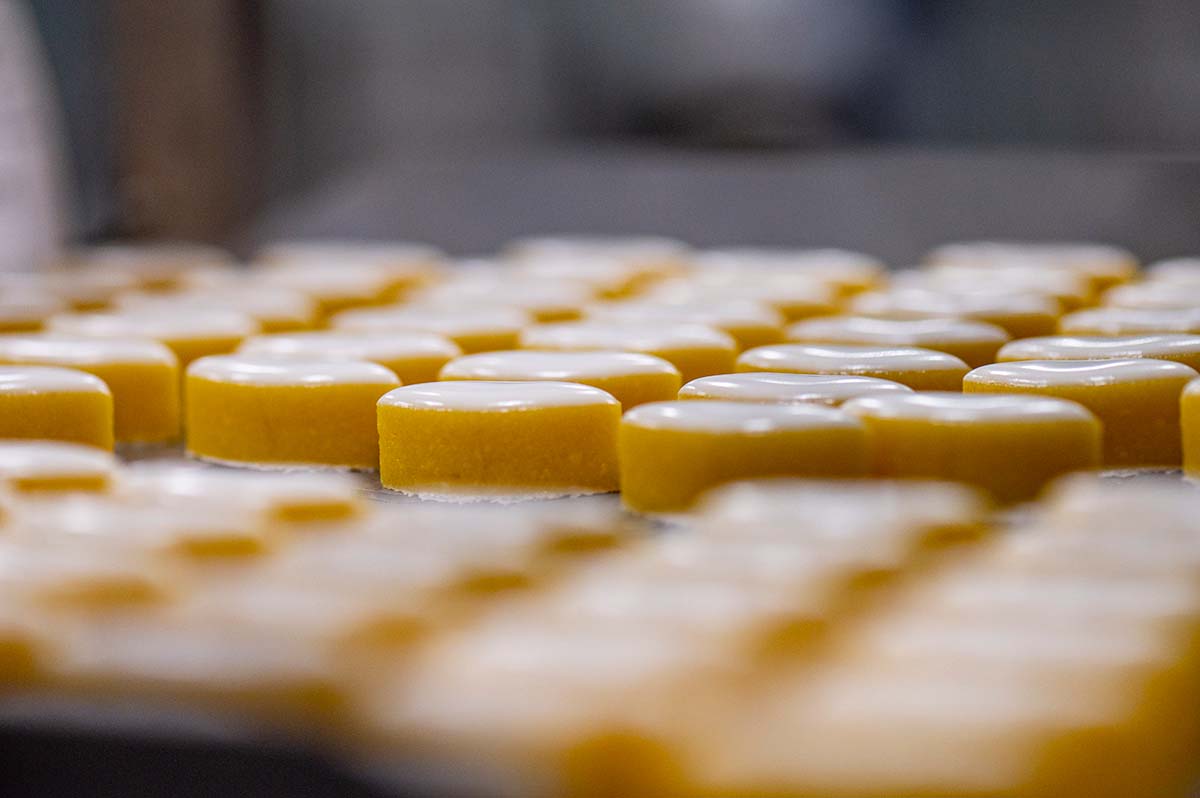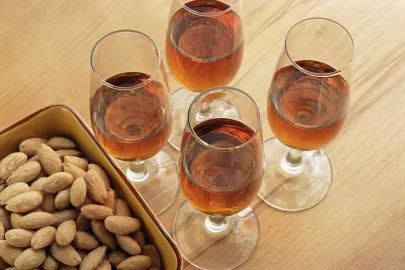My favorite place for sweet treats used to be the Chocolate Factory owned by Willy Wonka – until, that is, I visited Roy René’s confectionary west of Aix-en-Provence. Here, calissons replaced marshmallow chocolates, but the taste of adventure is just as delicious as ever.

A Symphony of Sweetness
Back then, I must have been six years old. Yes, Charlie and the Chocolate Factory was long, long ago, at that age when a nice story ensures a good night’s sleep. Today, now past thirty, I find myself in front of Roy René’s confectionery, 100 years old and world renowned. Here, I’ve heard, they make real delicacies. Indulgence comes in the shape of an almond and bears the sweet name calisson. Standing in front of this institution, I take measure of its success and metamorphosis: the tiny atelier of the founder, Ernest Guillet, a modest nougat maker in the 1920s, has been transformed into a magnificent modern building set amidst an almond grove. As I go inside, I can’t help but think of Willy Wonka himself, who couldn’t “abide ugliness in factories!” Various hallways lead me into a big room that strangely reminds me of the Chocolate Factory’s “storerooms.” Beautiful bags brimming with Provençal almonds and incredible boxes with Cavaillon melon candied in Apt are meticulously preserved there.
The production room
After going down a few flights of stairs, I find myself standing in front of a shiny metal door leading to the nerve center of the whole factory, the heart of the whole business: the production room. To enter, I put on a red hairnet, a white mask and blue shoe covers. Thus clad in my incidentally patriotic garb, I recall the warnings of the owner of the chocolate factory: “Don’t lose your heads! Don’t get over-excited! Keep very calm!”
The door opens onto a fascinating spectacle. Machines of all shapes and sizes roar to life, mixing, kneading, grinding, piercing, compressing in one incredible din. Workers climb ladders to access the highest points, they turn cranks to open things, press green buttons to start, white buttons to pause, red buttons to stop, they check the contents of huge tanks, they take the temperature of the mixtures, they add, they adjust. Fantastic piping meanders from floor to ceiling without me being able to tell where it’s coming from or where it’s going. Amid this exhilarating hubbub, I can see the almonds, softened and then transformed into a grainy mash; farther on, sugar syrup and egg whites are added to the candied melon and orange peels to form the elegant royal icing. “Wonderful, isn’t it?” Grandpa Joe surely would have said. The compressed mixture is then set away from light and out of sight.
As I walk past a stack of boxes, I notice a distinct bustle around one machine. Nimble hands assemble the wafer sheet, mixture and icing at breakneck speed. Tens, hundreds, thousands of calissons appear before me in a magical procession.

© ©Divergence
Di calin soun
Five centimeters, twelve grams. A crisp surface, a tender core, an oblong shape: I hold in my hand what, in the 15th century, put a smile back on the face of Jeanne de Laval, the demanding wife of King René. “Di calin soun,” the king said – this is sweetness – responding to the courtiers who were wondering where this new source of satisfaction came from. Ever since, the prestige of these delicacies has spanned across time and space… In 2016, they almost became “Kalisong” under the impetus of an aspiring Chinese entrepreneur who tried to register the “Calisson d’Aix” trademark. This near mishap reminds me of Wonka’s own woes: didn’t he close up his factory after his secret recipes were stolen by jealous competitors? To save their business, calisson producers didn’t resort to Oompa-Loompas but to the law. They put aside their long-standing differences and together applied for a protected geographical indication (PGI). The place of manufacture, weight, size, and composition of the calisson d’Aix are now regulated by strict specifications that protect it from being misappropriated.
After waiting for ten minutes while the treats lightly brown in an oven at 155°F, I move on to the final packaging room. In the middle of the room, a fickle machine stubbornly disregards the settings of the technicians who persist in articulating its electric arms.
Elegant packages are seamlessly assembled by expert hands. Unlike Charlie’s, my visit doesn’t end with them handing over the keys to me: they safely remain in the hands of a proud Provencal, Olivier Baussan, who bought the company in 2014. In the end I leave with something even better: a box of delectable calissons, and the feeling that reality is sweeter than in the storybooks.

© Anna Pustynnikova












